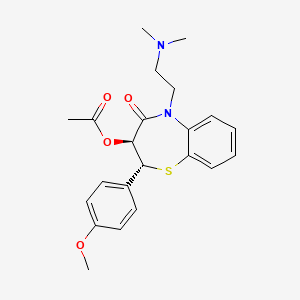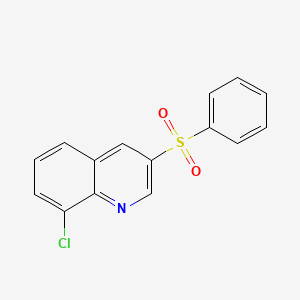
Unii-H9R95ET7JS
Overview
Description
The compound known as Unii-H9R95ET7JS, also referred to as Diltiazem EP Impurity A, has a molecular formula of C22H26N2O4S and a molecular weight of 414.52 g/mol. This compound is characterized by the presence of a benzothiazepin ring, a dimethylaminoethyl group, a methoxyphenyl group, and an acetate group. It is primarily used in research and industrial applications.
Preparation Methods
Synthetic Routes and Reaction Conditions
The synthesis of Unii-H9R95ET7JS involves several steps. One of the methods includes the following procedure:
Starting Material: 2-(4’-Methoxyphenyl)-3-acetoxy-2,3-dihydro-1,5-benzothiazepin-4(5H)-one.
Reagents: Sodium hydride, N,N-dimethylaminoethyl chloride, dimethylsulfoxide, acetic acid, benzene, diisopropyl ether.
Chemical Reactions Analysis
Unii-H9R95ET7JS undergoes various chemical reactions, including:
Oxidation: The compound can be oxidized under specific conditions to form different oxidation products.
Reduction: It can be reduced using common reducing agents like lithium aluminum hydride.
Substitution: The compound can undergo substitution reactions, particularly nucleophilic substitution, due to the presence of reactive functional groups.
Common Reagents and Conditions: Reagents such as sodium hydride, dimethylsulfoxide, and N,N-dimethylaminoethyl chloride are commonly used in its reactions.
Major Products: The major products formed depend on the specific reaction conditions and reagents used.
Scientific Research Applications
Unii-H9R95ET7JS has several scientific research applications, including:
Chemistry: Used as a reference standard in analytical chemistry for the identification and quantification of impurities in pharmaceutical formulations.
Biology: Studied for its potential biological activities and interactions with various biomolecules.
Medicine: Investigated for its role as an impurity in the synthesis of Diltiazem, a calcium channel blocker used in the treatment of hypertension and angina.
Industry: Utilized in the development and quality control of pharmaceutical products.
Mechanism of Action
It may exert its effects by modulating calcium channels and influencing cellular signaling pathways involved in cardiovascular functions.
Comparison with Similar Compounds
Unii-H9R95ET7JS is similar to other benzothiazepine derivatives, such as:
Diltiazem: A well-known calcium channel blocker used in clinical settings.
Clentiazem: Another benzothiazepine derivative with similar pharmacological properties.
Tiazem: Shares structural similarities and is used in similar therapeutic applications.
This compound is unique due to its specific structural modifications, which may influence its reactivity and interactions with biological targets.
Properties
IUPAC Name |
[(2R,3S)-5-[2-(dimethylamino)ethyl]-2-(4-methoxyphenyl)-4-oxo-2,3-dihydro-1,5-benzothiazepin-3-yl] acetate | |
|---|---|---|
| Source | PubChem | |
| URL | https://pubchem.ncbi.nlm.nih.gov | |
| Description | Data deposited in or computed by PubChem | |
InChI |
InChI=1S/C22H26N2O4S/c1-15(25)28-20-21(16-9-11-17(27-4)12-10-16)29-19-8-6-5-7-18(19)24(22(20)26)14-13-23(2)3/h5-12,20-21H,13-14H2,1-4H3/t20-,21-/m1/s1 | |
| Source | PubChem | |
| URL | https://pubchem.ncbi.nlm.nih.gov | |
| Description | Data deposited in or computed by PubChem | |
InChI Key |
HSUGRBWQSSZJOP-NHCUHLMSSA-N | |
| Source | PubChem | |
| URL | https://pubchem.ncbi.nlm.nih.gov | |
| Description | Data deposited in or computed by PubChem | |
Canonical SMILES |
CC(=O)OC1C(SC2=CC=CC=C2N(C1=O)CCN(C)C)C3=CC=C(C=C3)OC | |
| Source | PubChem | |
| URL | https://pubchem.ncbi.nlm.nih.gov | |
| Description | Data deposited in or computed by PubChem | |
Isomeric SMILES |
CC(=O)O[C@@H]1[C@H](SC2=CC=CC=C2N(C1=O)CCN(C)C)C3=CC=C(C=C3)OC | |
| Source | PubChem | |
| URL | https://pubchem.ncbi.nlm.nih.gov | |
| Description | Data deposited in or computed by PubChem | |
Molecular Formula |
C22H26N2O4S | |
| Source | PubChem | |
| URL | https://pubchem.ncbi.nlm.nih.gov | |
| Description | Data deposited in or computed by PubChem | |
Molecular Weight |
414.5 g/mol | |
| Source | PubChem | |
| URL | https://pubchem.ncbi.nlm.nih.gov | |
| Description | Data deposited in or computed by PubChem | |
CAS No. |
111188-71-7 | |
| Record name | (2R,3S)-5-(2-(Dimethylamino)ethyl)-2-(4-methoxyphenyl)-4-oxo-2,3,4,5-tetrahydro-1,5-benzothiazepin-3-yl acetate | |
| Source | ChemIDplus | |
| URL | https://pubchem.ncbi.nlm.nih.gov/substance/?source=chemidplus&sourceid=0111188717 | |
| Description | ChemIDplus is a free, web search system that provides access to the structure and nomenclature authority files used for the identification of chemical substances cited in National Library of Medicine (NLM) databases, including the TOXNET system. | |
| Record name | (2R,3S)-5-(2-(DIMETHYLAMINO)ETHYL)-2-(4-METHOXYPHENYL)-4-OXO-2,3,4,5-TETRAHYDRO-1,5-BENZOTHIAZEPIN-3-YL ACETATE | |
| Source | FDA Global Substance Registration System (GSRS) | |
| URL | https://gsrs.ncats.nih.gov/ginas/app/beta/substances/H9R95ET7JS | |
| Description | The FDA Global Substance Registration System (GSRS) enables the efficient and accurate exchange of information on what substances are in regulated products. Instead of relying on names, which vary across regulatory domains, countries, and regions, the GSRS knowledge base makes it possible for substances to be defined by standardized, scientific descriptions. | |
| Explanation | Unless otherwise noted, the contents of the FDA website (www.fda.gov), both text and graphics, are not copyrighted. They are in the public domain and may be republished, reprinted and otherwise used freely by anyone without the need to obtain permission from FDA. Credit to the U.S. Food and Drug Administration as the source is appreciated but not required. | |
Synthesis routes and methods
Procedure details










Disclaimer and Information on In-Vitro Research Products
Please be aware that all articles and product information presented on BenchChem are intended solely for informational purposes. The products available for purchase on BenchChem are specifically designed for in-vitro studies, which are conducted outside of living organisms. In-vitro studies, derived from the Latin term "in glass," involve experiments performed in controlled laboratory settings using cells or tissues. It is important to note that these products are not categorized as medicines or drugs, and they have not received approval from the FDA for the prevention, treatment, or cure of any medical condition, ailment, or disease. We must emphasize that any form of bodily introduction of these products into humans or animals is strictly prohibited by law. It is essential to adhere to these guidelines to ensure compliance with legal and ethical standards in research and experimentation.


![(6R)-4-hydroxy-2-methyl-6-[(8R,9S,10S,13R,14S,17R)-3,7,12-trihydroxy-10,13-dimethyl-2,3,4,5,6,7,8,9,11,12,14,15,16,17-tetradecahydro-1H-cyclopenta[a]phenanthren-17-yl]heptanoic acid](/img/structure/B1168218.png)
